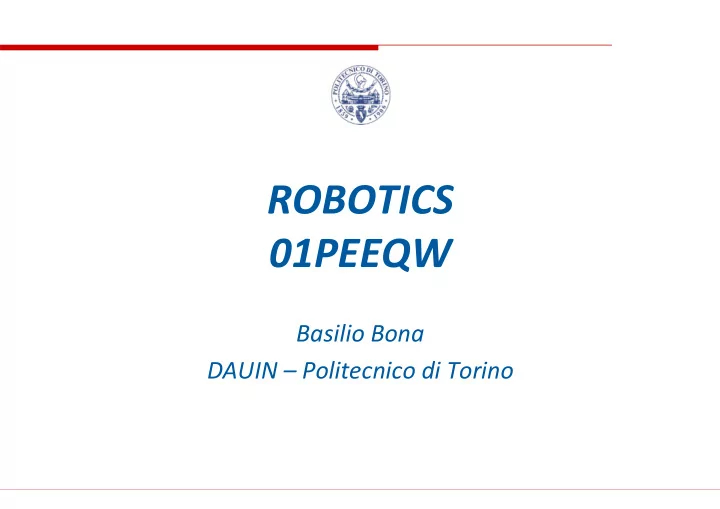

ROBOTICS 01PEEQW Basilio Bona DAUIN – Politecnico di Torino
What is Robotics? Robotics studies robots For history and definitions see the 2013 slides http://www.ladispe.polito.it/corsi/meccatronica/01PEEQW/2014-15/Slides/Robotics_2013_01_A_brief_history.pdf http://www.ladispe.polito.it/corsi/meccatronica/01PEEQW/2014-15/Slides/Robotics_2013_02_Introduction.pdf Robots can be used in different contexts and are classified as 1. Industrial robots 2. Humanoid & biomimetic robots 3. Service robots 4. Exploration robots 5. Service & exploration robots can be a) wheeled (rovers) b) flying (UAS,UAV, Quadcopters, etc.) c) legged There is a partial overlapping of these classes Basilio Bona 2 ROBOTICS 01PEEQW - 2014/2015
Industrial robots � Similar to a human arm with a wrist and a final “hand” for holding tools � Rigid mechanical structure to guarantee accuracy and precision (repeatability) � 5-6 (rarely 7) dof � Internal (proprioceptive) joint sensors only * recent developments include vision sensors � High payloads � Reduction gears � Well known and quasi-static environment � Strict safety requirements � Externally supplied power Basilio Bona 3 ROBOTICS 01PEEQW - 2014/2015
Humanoid robots � Similar to human body with a torso, two arms, two legs, 2-5 fingered hands � Complex mechanical structure to guarantee stable bipedal motion � Many dofs � Internal and external sensors � Low payloads � Reduction gears or direct drives � Unknown and changing environment: land only � Limited autonomy � Safety requirements TBD � HMI and social acceptance issues Basilio Bona 4 ROBOTICS 01PEEQW - 2014/2015
Examples from DRC 2013 Basilio Bona 5 ROBOTICS 01PEEQW - 2014/2015
Lots of onboard sensors Basilio Bona 6 ROBOTICS 01PEEQW - 2014/2015
Examples Basilio Bona 7 ROBOTICS 01PEEQW - 2014/2015
Biomimetic robots � Similar to animals, insects, fishes, birds, etc. � May have more than two legs, no legs at all, wings, fins; can walk, crawl, swim, fly � Internal and external sensors � Low – medium payloads, depending on structure � No safety requirements � Unknown and changing environment: sea, air, land Basilio Bona 8 ROBOTICS 01PEEQW - 2014/2015
Service robots � May have different motion structures: mostly wheeled (differential drives or 4-wheels), but UAVs are becoming popular � Mechanical structure is important, but software is a critical issue � Internal and external sensors � Cameras (single, stereo 3D, ToF, omnidirectional) � Laser scanners and Lidars � Proximity sensors � Special purpose, e.g., thermo-cameras � Low to medium size payloads (according to use) � HMI is important � Unknown and changing environment: indoor (flat), outdoor (land, air, underwater) � Privacy and legal issues important Basilio Bona 9 ROBOTICS 01PEEQW - 2014/2015
UAVs � U nmanned A erial (or A utonomous) V ehicles are known due to their use as military drones, but now “quadcopters” are very common � Civil applications are becoming important � surveillance and patrolling of large structures and sites � disaster area analysis; search and rescue (SAR) � agricultural and environmental remote sensing � leisure: commercial and filmmaking � material transport � Mainly outdoor, but indoor use is gaining interest � Unknown environment � Limited payload � Limited autonomy (battery life is critical) and often tele-operated � Mostly vision sensors (lightweight) � Privacy and legal issues important Basilio Bona 10 ROBOTICS 01PEEQW - 2014/2015
Examples Basilio Bona 11 ROBOTICS 01PEEQW - 2014/2015
Exploration robots � Used for planetary or deep space exploration � e.g., Spirit, Opportunity, Curiosity, future Moon and Mars rovers � Some used for underwater or harsh environments (volcanoes, Antarctica exploration, etc.) � Usually tele-operated, but partial autonomy necessary due to long time delays between Earth and Mars Basilio Bona 12 ROBOTICS 01PEEQW - 2014/2015
Course content – 1 � Kinematic Chains: constitutive elements; KC types: open, closed; KC dofs: redundant, non redundant chains � Industrial robot types: arms and wrists � Kinematic chains: algorithms for fast computation of direct and inverse position and velocity kinematic functions � Denavit-Hartenberg conventions and DH parameters � Homogeneous matrices � Jacobian matrices � Statics: kineto-static relations � Dynamics: Lagrange equations, general form for control � Control algorithms: independent joints linear control, MIMO nonlinear control Basilio Bona 13 ROBOTICS 01PEEQW - 2014/2015
Course content – 2 � Wheeled rovers � structures, � differential drive kinematics � non-holonomy � odometry issues � Onboard sensors: some types will be briefly analyzed � Mapping, localization and SLAM issues � Path planning Basilio Bona 14 ROBOTICS 01PEEQW - 2014/2015
Recommend
More recommend